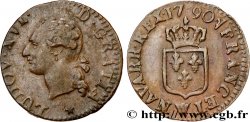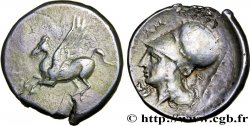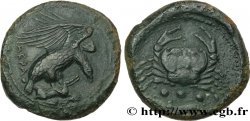Live auction - bry_520616 - LOUIS XVI Écu dit "de Calonne", frappe à trois pans de virole 1786 Paris
You must signin and be an approved bidder to bid, LOGIN TO BID. Accounts are subject to approval and the approval process takes place within 48 hours. Do not wait until the day a sale closes to register. Clicking on "BID" constitutes acceptance of the terms of use of cgb.fr private live auctions.
Bids must be placed in whole Euro amounts only. The sale will start closing at the time stated on the item description; any bids received at the site after the closing time will not be executed. Transmission times may vary and bids could be rejected if you wait until the last second. For further information check the Live auction FAQ
All winning bids are subject to a 18% buyer’s fee.
All winning bids are subject to a 18% buyer’s fee.
| Estimate : | 2 500 € |
| Price : | 1 600 € |
| Maximum bid : | 2 100 € |
| End of the sale : | 05 March 2019 16:39:46 |
| bidders : | 3 bidders |
Type : Écu dit "de Calonne", frappe à trois pans de virole
Date: 1786
Mint name / Town : Paris
Metal : silver
Millesimal fineness : 917 ‰
Diameter : 41 mm
Orientation dies : 6 h.
Weight : 28,37 g.
Edge : En relief à trois pans de virole / (lis) DOMINE (lis) /SALVUM (lis) F/AC (lis) REGEM
Rarity : R2
Coments on the condition:
Cette refrappe est frappée sur un flan large et régulier. Exemplaire présentant de hauts reliefs. Petite tache devant le torse du roi et coup sur la tranche à 6 heures au revers. De petites traces de manipulation dans le champ du revers
Obverse
Obverse legend : LUD. XVI. D. G. FR. ET NAV. REX..
Obverse description : Grande tête laurée à gauche de Louis XVI ; signé au-dessous J.P. DROZ. F. ; listel formé de petits lis.
Obverse translation : (Louis XVI, par la grâce de Dieu, roi de France et de Navarre).
Reverse
Reverse legend : SIT NOMEN DOMINI - A - BENEDICTUM (TÊTE D'AIGLE) 1786.
Reverse description : Deux L formées d'une palme et d'une branche d'olivier entrecroisées et sommées d'une couronne ; à l'intérieur 3 lis posés 2 et 1.
Reverse translation : (Béni soit le nom du Seigneur).
Commentary
Jean-Pierre Droz, d'origine suisse, réalisa en 1786 et 1787 une série d'essais qui ne furent jamais adoptés. Ces essais, louis et écus, sont dits "de Calonne", du nom du contrôleur général des Finances de l'époque. Ce type d'écu d'argent eut tellement de succès qu'il fut refrappé au XIXe siècle sous la Restauration. Droz a employé pour la tranche la virole brisée à six parties alors que la refrappe n'en comporte que trois (comme cet exemplaire). Jean-Pierre Droz grava également plusieurs essais pendant la Révolution et l'Empire ainsi que des pièces pour le royaume de Westphalie de Jérôme Napoléon (1807-1813).
Jean-Pierre Droz, of Swiss origin, produced a series of tests in 1786 and 1787 that were never adopted. These tests, louis and écus, are called \\\"de Calonne\\\", from the name of the Comptroller General of Finances at the time. This type of silver écu was so successful that it was re-struck in the 19th century under the Restoration. Droz used the six-part broken ferrule for the edge, whereas the re-struck only has three (like this example). Jean-Pierre Droz also engraved several tests during the Revolution and the Empire, as well as coins for the Kingdom of Westphalia of Jérôme Napoléon (1807-1813).
Jean-Pierre Droz, of Swiss origin, produced a series of tests in 1786 and 1787 that were never adopted. These tests, louis and écus, are called \\\"de Calonne\\\", from the name of the Comptroller General of Finances at the time. This type of silver écu was so successful that it was re-struck in the 19th century under the Restoration. Droz used the six-part broken ferrule for the edge, whereas the re-struck only has three (like this example). Jean-Pierre Droz also engraved several tests during the Revolution and the Empire, as well as coins for the Kingdom of Westphalia of Jérôme Napoléon (1807-1813).








 Report a mistake
Report a mistake Print the page
Print the page Share my selection
Share my selection Ask a question
Ask a question Consign / sell
Consign / sell
 Full data
Full data















